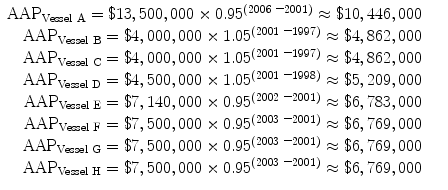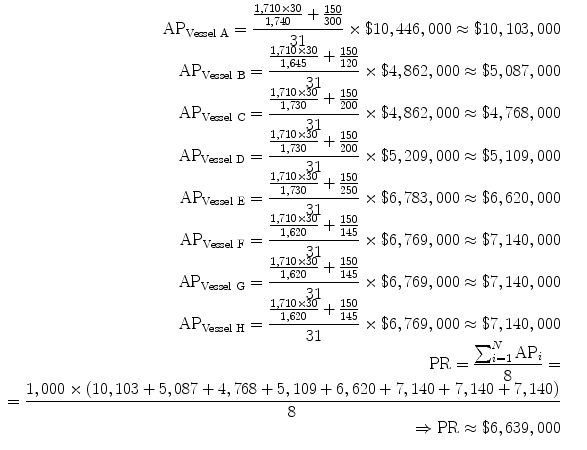Developing a Dynamic Vessel Valuation Method Based on Real Market Transactions
(10.1)
where:
AAP i = age adjusted price of vessel i
PC i = price of comparison vessel i
AC i = age of comparison vessel i
AR = age of rated vessel
SV i = scrap value of vessel i
SP = scrap price per light displacement ton
ldt i = light displacement tons of vessel i
Intuitively, we appreciate the value of the transaction price of a comparison vessel by 5 % for every year that the comparison vessel is older than the vessel that needs to be evaluated. For every year, that the comparison vessel is younger than the evaluated vessel the transaction price needs to be depreciated by 5 % unless the vessel’s scrap value is reached.
Numerical Example
To give a numerical example, we assume that we want to estimate the market value of the fictitious vessel Titanic Voyager. As per Table 10.1, it is a geared feeder vessel built in 2001 with 1,710 TEU and 150 reefer plugs. The task is to estimate the value in April 2013. Since the beginning of the year 2013 there have been eight suitable comparison transactions, which are listed in the overview Table 10.2.
Table 10.1
Data of the ship under scrutiny
Name
TEU
Reefer
Gear
Built
Date
Price
Titanic Voyager
1,710
150
Geared
2001
April 13
?
Table 10.2
Data of suitable comparison transactions
Name
TEU
Reefer
Gear
Built
Date
Price
Vessel A
1,740
300
Geared
2006
January 13
$13,500,000
Vessel B
1,645
120
Geared
1997
January 13
$4,000,000
Vessel C
1,730
200
Geared
1997
February 13
$4,000,000
Vessel D
1,730
200
Geared
1998
February 13
$4,500,000
Vessel E
1,730
250
Geared
2002
March 13
$7,140,000
Vessel F
1,620
145
Geared
2003
March 13
$7,500,000
Vessel G
1,620
145
Geared
2003
March 13
$7,500,000
Vessel H
1,620
145
Geared
2003
March 13
$7,500,000
Age Adjustment
Thus, to calculate the age-adjusted price for each vessel we need to apply the above formula. For PC i we plug in the respective sales price [see Eq. (10.2)]. In the exponent, we put the respective age difference between the comparison vessel and the Titanic Voyager.

(10.2)
Attribute Adjustment
Having adjusted the comparison vessels’ transaction prices for their major attribute, we still need to adjust the vessels for some minor attributes. Those attributes can be manifold and it always lies in the eye of the beholder which attributes to include or not to include in this adjustment process. Usually those attributes can be e.g. (nominal or homogeneous) capacity, building land (as far as that refers to the vessel’s quality), consumption (especially in times of expensive fuel), auxiliaries, reefer plugs, etc. Whether to include an attribute in the valuation and how to weigh this attribute is a crucial issue that will influence our result. Hence, quite some time should be invested in this decision. The attribute selection could be based on experience or on quantitative methods.2 To simplify we will take for granted that in our market only two attributes have a significant influence on the price of the vessel: nominal capacity (in some cases it could make sense to judge by the homogeneous capacity) and reefer plugs. Additionally, we assume a weight of 30 for the nominal capacity and a weight of one for the reefer plugs. In the following, we will deploy a trivial formula that adjusts the age adjusted prices by the missing significant attributes.
where:

(10.3)
AAP i = age adjusted price of vessel i
PR = price rated vessel
TEU r = TEU of rated vessel
 of comparison vessel i
of comparison vessel i
REEFER r = Reefer plugs of rated vessel
 Reefer plugs of comparison vessel i
Reefer plugs of comparison vessel i
AP i = adjusted price of vessel i
N = number of comparison vessels
In a first step, we multiply the age-adjusted price of each comparison vessel with the weighed ratio of the other attributes. This grants the “adjusted price” for each vessel. In a final step, we take the mean of the adjusted prices for each vessel, which equals the price of the rated vessel or more precisely the estimated market value of the evaluated vessel. Plugging in the numbers of our previous example we derive the following numeric equations [see Eq. (10.4)]:

(10.4)
By adjusting the values of the suitable second-hand transactions observed we have derived the current market value of the Titanic Voyager. Based on the observed transactions its market value is approximately $6,639,000.
10.3.4 Criticism
So far we have derived a simple method that instructs us in how to approximate the market value of a given vessels by adjusting transaction prices of suitable comparison vessels. Compared to the rather intuitive approach of common broker evaluation this approach has the advantage that the evaluation follows a mathematically and precisely defined algorithm, and if applied properly it delivers robust results. Compared to the LTAV method, it is of non-hypothetical nature, as the values are orientated on real-market transactions.
However, this evaluation method has its weaknesses. For a start, it is a past-orientated method. As it utilizes comparison sales that occurred in “past months”, the result is the value the respective vessel had at the time the comparison vessels were sold. However, unless we are conducting an ex-post valuation we are interested in the value it has at present. It is quite likely that the market level has changed since the comparison sales were transacted. So far, the AELD does not consider this.
Another weakness of the approach is that the age adjustment is static. Age-related attrition of a vessel depends on several factors.3 However, as described above, the major factor of change in the pace of attrition is the market situation. In a “good market”, vessels will devaluate more slowly than in a “bad market”. Nevertheless, as it stands the AELD assumes 5 % of devaluation per annum.
Moreover, it has to be noted that the influence of the attributes on the transaction price may differ in reality and thus could bias the assessment result. Furthermore, the validity of the result depends on the choice of the comparison vessels.
10.4 Qualitative Adjusted and Audited Algebraic Estimation on the Bas is of “Last Done”
Even though we have developed a method that delivers robust results, the AELD still faces a couple of weaknesses as shown in the criticism above. In the following, we will elaborate our method further. We will demonstrate how to test the validity of an age adjustment factor and how to factor in a change of age related attrition. We will show how to incorporate possible market change since the observation of comparison transactions, enabling the estimation of current market values. Furthermore, we will briefly introduce a statistical method of testing attributes significance. Finally, we will discuss methods of ex-post auditing to ensure the result’s validity.
10.4.1 Incorporating Market Changes
Unfortunately, we do not always have comparison sales available to judge a vessel’s value today. It is quite possible that the last observed transactions date back a couple of months or even years. Normally some time has passed since the last realized transactions that suit as benchmark sales. However, it is likely that the market level has moved since then. To allow for the market movement between the time of the comparison vessel’s transaction and the present, we have to incorporate market change. Hence, we will construct a factor that compensates the market movement between the time of observed comparison transaction and time of market value assessment. To value the change in market level we make use of the significant correlation between the charter and the second-hand market. While the second-hand market reveals just a few transactions, the charter market is (for most vessel sizes) more vibrant and delivers a continuous flow of fixtures and thus information on the market level. Hence, the charter market movement is the best available proxy for the change of second-hand market level.4